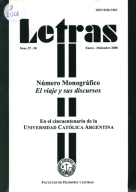Please use this identifier to cite or link to this item:
https://repositorio.uca.edu.ar/handle/123456789/4515| Título: | Geografía, teología e historia : algunas consideraciones sobre los mapas medievales | Autor: | Rubio Tovar, Joaquín | Palabras clave: | EDAD MEDIA; CARTOGRAFIA; MAPAS; LITERATURA MEDIEVAL | Fecha de publicación: | 2008 | Editorial: | Universidad Católica Argentina. Facultad de Filosofía y Letras | Cita: | Rubio Tovar, Joaquín. “Geografía, teología e historia : algunas consideraciones sobre los mapas medievales” [en línea]. Letras, 57-58 (2008). Disponible en: https://repositorio.uca.edu.ar/handle/123456789/4515 | Resumen: | Número monográfico: El viaje y sus discursos Resumen: Durante mucho tiempo, los mapas realizados en la Edad Media han sido entendidos no ya como inexactos y profundamente equivocados, sino como pintorescos e ingenuos. La idea que subyace a esta teoría es que un mapa sólo debe valorarse según el parecido con la realidad representada. Hace ya años, sin embargo, que los mapas han dejado de juzgarse sólo por el grado de fidelidad con la que representan el mundo, entre otras cosas porque aquellos mapas no pretendían la exactitud que nosotros exigimos. Los mapas antiguos no deben juzgarse solamente por su visión de la realidad física, sino como testimonio de otros intereses. Podían mostrar una imagen del mundo y de la historia inspirada en la Biblia y los santos padres, indicar las rutas de peregrinos, señalar hechos destacados de la historia pagana, presentar algunos accidentes geográficos o cómo estaban dispuestos los continentes, y, en definitiva, crear un orden para aprehender o explicar la realidad. Todo esto los convierte en un documento de enorme interés. Abstract: For a long time, Medieval maps have been understood not only as inexact and totally incorrect, but also as picturesque and naïve. The idea behind that theory is that the value of a map depends only on its resemblance to the represented reality. In the last years, however, maps have no longer been judged by their degree of realism, partly because those maps did not aim at the exactness that we require nowadays. Ancient maps should not only be judged by their vision of the physical reality, but as a testimony of other interests. They could show an image of the world and its history inspired in the Bible or the holy fathers, indicate the roads to pilgrims, highlight important facts of pagan history, represent some geographic accidents or how the continents were displayed, and, finally, create an order to apprehend or explain reality. All these features make them very interesting documents. |
URI: | https://repositorio.uca.edu.ar/handle/123456789/4515 | ISSN: | 0326-3363 | Disciplina: | LITERATURA | Derechos: | Acceso Abierto |
| Appears in Collections: | LETRAS - 2008 nro. 57-58 |
Files in This Item:
| File | Description | Size | Format | |
|---|---|---|---|---|
| geografia-teologia-historia-mapas-medievales.pdf | 202,1 kB | Adobe PDF |  View/Open |
Page view(s)
777
checked on Apr 30, 2024
Download(s)
414
checked on Apr 30, 2024
Google ScholarTM
Check
This item is licensed under a Creative Commons License

